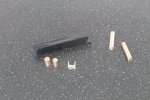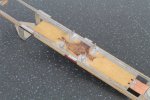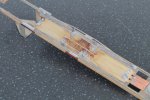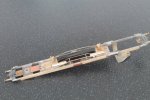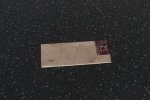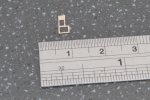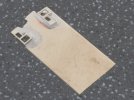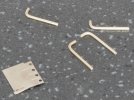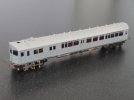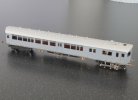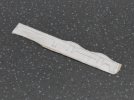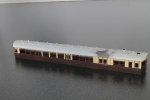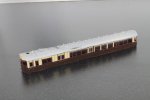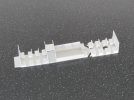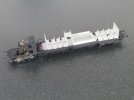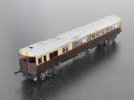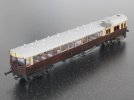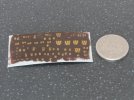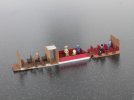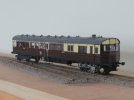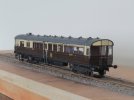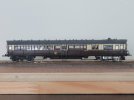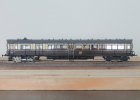With the Steam Rail Motor now out of the way, I decided to resurrect/start (and finish) some wagon projects. I only had 35 wagons of which 4 were Brake Vans, and since my longest train could be 10 wagons (incl. Brake Van) I really need quite a few more!
Some time ago, I made up a pair of Iron Mink vans. These were 3D prints courtesy of Richard Brummitt. I had built them but hadn't got round to painting them, so as a "quicky" they had to be done first. I painted one in GWR Red and the other in GWR Dark Grey. Richard had sent me one with a long bonnet and one with a short, checking the HMRS volume on Iron Minks I've made the short bonnet one Red and the long bonnet one Grey.
The lettering on the Red one is Fox transfers (although annoyingly their sheets don't include the "To Carry" wording that would normally go in front of the "x Tons" branding). Therefore I have had to omit the "To Carry" as I've had to on pretty well all of my wagons, although in this case there almost certainly wouldn't have been room between the vertical strapping for it to fit anyway!
For the Grey one, I've decided to fit "cast plates" carrying the number and "G.W.R". There is some debate as to whether the cast plates were fitted to Red wagons or Grey. Long ago, I put my stake in the ground and decided that any cast plate wagons on Modbury would be Grey. My "argument" (NOT proof) for this is quite simply that some wagons retained their plates when re-lettered with 25" GW circa 1904 (when general opinion agrees that the wagons would be Grey). Additionally, one of the wagons that we have photographic evidence of in that guise (25" GW with cast plate numbers) is an Iron Mink, and there is a mis-matched colour patch on the body side where the "G.W.R" plate was, I can't believe that the Great Western would have allowed the wagon to return to service with a small Red patch on an otherwise Grey wagon, but can believe that it was Grey so the painters left it (albeit a slightly different shade that perhaps the photographic emulsion made more contrasty).
Anyway, here are the two Iron Mink vans :
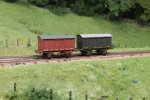
The "cast plates" were made by painting a piece of 0.005" plasticard in Humbrol Dark Grey (no. 67 - the colour I use for my grey wagons). The lettering and numbering was then scratched off with a sharp needle in a pin vice to reveal the white of the plasticard , and the plate cut out around the writing. Comparing the two wagons I need to put a bit of rust on the Red one as in theory the livery is older than the grey one!
In addition to the vans, I've also added some Opens too. A pair of 4 plank Opens and a 5 plank Open with sheet rail. The basis of all three is the Association body kit(s) for the 4 plank O5 and 5 plank O3. The 4 plankers were made up and stuck on some Association underframes. The 5 plank O3 received a bit of surgery to convert it to an earlier diagram O4. This required slicing/sanding off some of the top plank to make it the same size as the other 4 planks. The diagonal strapping was scraped off and reinstated with 0.005" plastic strip, and the vertical stanchions either side of the doors were reduced to flat strapping . Obviously, the sheet bar had to be fabricated too. Once again, these have been finished in the pre-1904 liveries of Red with painted lettering or Grey with cast plates :
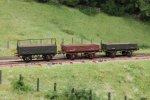
I might re-visit the O4 5 planker, and put some Archer's rivet transfers on the diagonal strapping as looking at it now I feel it is noticeable by it's absence!
Finally, I've added another Cattle Wagon to diagram W1 (this time with flat diagonal strapping), and in Red livery, and added a load of planks to another 4 planker that was previously made. Additionally, at the 2mm Association Diamond Jubilee event, Kevin Knight kindly gave me one of the Tar Wagon bodies that the Australian contingent produced a couple of years ago. A suitable underframe was built up and stuck under it, a little locking handle was filed up from a small piece of 0.010" nickel silver and stuck on the tank filler. Once painted black, the Wm. Butler transfers that Kevin also supplied were applied. Unfortunately, when I came to dirty the wagon, it seems that the enamel thinners that I was using attacked the decals!! It had been my intention to build up a degree of dirt by applying thin washes of colour. The result was that I had to reinstate some of the lettering with white enamel and a fine brush and then make it even dirtier than I had intended to hide the damage!! Anyway, it does make a nice addition to the stock being a privately owned wagon (and not an Open coal wagon) :
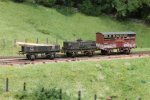
So now I have 42 wagons, and am almost ready to take Modbury to RailWells in mid-August!!
Thanks for looking
Ian
